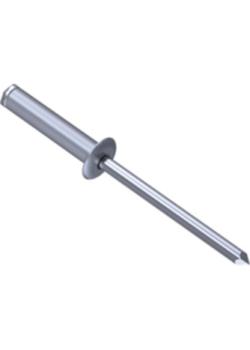|
€ 5,19 (€ 0,52 / Piece)
|
| Price incl. VAT |
| plus € 29,00 shipping costs |
Delivery time 7-10 working days
Do you have any questions?
We would like to assist you!
We would like to assist you!
Item No.:
928014649252
Application
- GESIPA blind rivets are a reliable method for permanently secure joining of various materials, even sensitive ones.
- The efficient technology of GESIPA blind riveting has become indispensable in modern industrial productions requiring joining technology due to its economy and versatility. It enables limited component accessibility to be overcome and a wide variety of materials, even sensitive ones, to be joined permanently and securely. If desired, even the setting process can be documented.
- Technically, the blind rivet consists of two components, the hollow rivet and the mandrel. In contrast to screws, clinching or self-pierce rivets, the blind rivet only requires access to one side of the component, which makes it special.
- During the setting process, the setting tool pulls the mandrel with the chuck jaws and deforms the hollow rivet until it is firmly seated in the component. At the predetermined breaking point, the mandrel finally breaks off and the residual mandrel can be recycled. The residual mandrel remains in the hollow rivet and, depending on the application, can assume an additional securing function.
- GESIPA blind rivets are available in various specifications, materials, shapes, lengths and colors. Depending on the requirements, a choice can be made between standard models available from stock or GESIPA blind rivets specially designed for a particular application.
- A rule of thumb for determining the rivet shaft length is: material thickness + rivet shaft diameter = rivet shaft length.
- Further technical data on GESIPA blind rivets are available.
- The blind rivet consists of two parts: the hollow rivet and the mandrel.
- The hollow rivet is composed of the setting head and the hollow rivet shank.
- The setting head is located on the processing side and is variable in diameter and shape. There are variants such as flat round head, countersunk head and large head. The rivet shank is available in different lengths, depending on the material thickness to be riveted.
- The rivet mandrel has the task of deforming the rivet shank and contains the predetermined breaking point. After deformation of the rivet, the mandrel breaks off at this point.
- The residual mandrel is the part of the rivet mandrel that remains in the hollow rivet. The residual mandrel is the part of the rivet mandrel that is torn off from the set rivet by means of a blind rivet setter.
- Material - aluminum/steel
- Size - 5 x 12 mm
- VE - 10 piece
Product safety
Manufacturer: SFS Group Germany GmbH, Nordendstr. 13-39, 64546 Mörfelden-Walldorf, Germany, www.gesipa.com, info@gesipa.com
Ratings
No evaluation has been given




